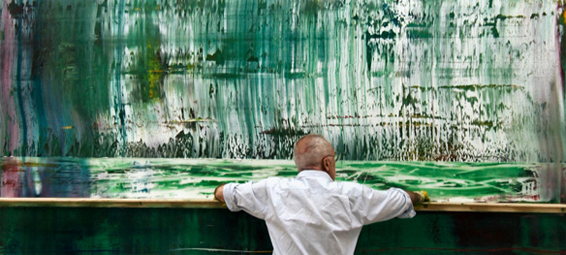“The paintings I like the most are the ones I don’t understand,” artist Gerhard Richter says to the filmmaker Corinna Belz in the opening act of her documentary, Gerhard Richter – Painting. It is a statement that seems to guide Belz’s own approach to her film, a documentary that doesn’t belabor its efforts to understand Richter or explicate his work, but is more interested in simply watching and listening to the artist, primarily when he is at work.
We watch Kiefer paint, working on a series of abstracts. He drags long palates of paint across canvases layered with color, blending and blurring, sometimes building up complicated mixes of vibrant hues only to scrape a long roll of white or soft grey over it, obscuring days of work. Sometimes Richter makes mistakes, or just makes too many choices. He has to walk away, let the paint dry, let the pieces stay unfinished until he can re-approach them again. At one point, Richter admits that being filmed making work is torture, “worse than being in the hospital,” he says. All the while Richter’s approach emerges as a kind fumbling and a kind of play, a patient search for the finished work.
Among the conversations that populate the film, the most fascinating ones deal with this question of the finished work. Richter admits he is painting without a plan, as he discusses with an art historian friend, yet he knows when a painting is done. He also knows when he finds himself making too many choices, trying to do too much to a piece. Belz also includes conversations with the artists about growing up in East Germany, his studies, his love of photos, and we follow Richter on a few occasions out of the studio to visit museums staging shows of his work.
The running theme through it all is the artist’s critical eye. He ridicules the lighting in a museum inCologne; he shares an amusing anecdote about his first American show, when someone complimented his photo-realist pieces only to turn and bluntly lambast his mono-toned canvases. Richter also shares an illuminating story about an art school classmate who painted flowers and whistled while he worked. Richter admonished the young artist for being too satisfied with his own work. It is that dissatisfaction, those high painterly standards that still drive Richter’s own expectations for his own work. Painting, it would seem, like documentary filmmaking, has as much to do with looking as it does with doing.






